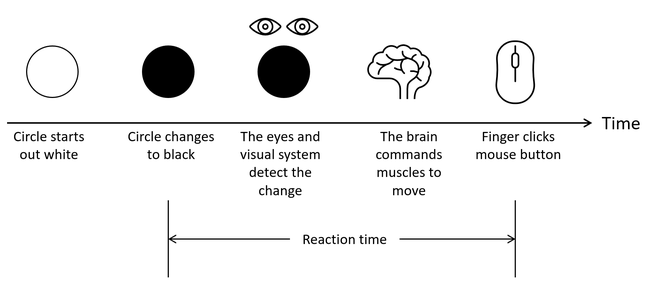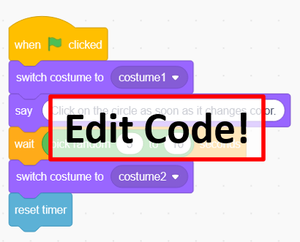Abstract
Does talking on a cell phone make one a more dangerous driver? Here is an experiment you can do to investigate whether reaction time is adversely affected by a simultaneous phone conversation.
Summary
None
Readily available. You will need a cell phone with hands-free operation capability.
No issues
Andrew Olson, Ph.D., Science Buddies
Ben Finio, Ph.D., Science Buddies
Ghez, C., 1991. "Voluntary Movement," in Kandel, E., J.H. Schwarz and T.M. Jessell. Principles of Neural Science: Third Edition. Norwalk, CT: Appleton & Lange.
Goldrich, A.M., 2004. Does Cell Phone Usage Affect Reaction Time? California State Science Fair, Project Number J0312.

Objective
The goal of this project is to determine whether or not engaging in a cell phone conversation adversely affects reaction time.
Introduction
What happens if a person talking on a cell phone is behind the wheel of a car, traveling at highway speed, or negotiating busy downtown traffic? Is a cell phone conversation enough of a distraction to make the driver more dangerous? If the phone is a distraction, does using a hands-free cell phone improve the situation?
Here is a science fair project that you can do to try and address some of these questions. You'll design and conduct an experiment to measure the effect of cell phone use on reaction time. Reaction time is the time that elapses between a sensory stimulus and the response to that stimulus. Thus, it is a measure of the total time necessary for a chain of internal events (Figure 1):
- the stimulus activates one or more sensory receptors,
- the receptor(s) send a signal to the central nervous system (CNS),
- the CNS processes the incoming signal and elicits a neural response,
- which must then travel to the appropriate muscles in order to generate the physical response.
 Image Credit: Ben Finio, Science Buddies / Science Buddies
Image Credit: Ben Finio, Science Buddies / Science Buddies
Figure 1. This drawing shows that reaction time is the time from the presentation of a stimulus (in this example, the stimulus is the black circle) to the time of a reaction to that stimulus (when the user clicks the mouse button).
"Under optimal conditions of attention, we can respond to a sensory stimulus in 120 to 150 ms." (Ghez, 1991) The shorter time (120 ms) is for proprioceptive or auditory stimuli. (Proprioceptive stimuli result from mechanical displacement of the muscles or joints. An example is when your doctor taps your knee to test your reflexes. Your doctor is checking your reaction time.) The longer time (150 ms) is for visual stimuli, due to additional synapses in the retina. Reaction time will be even longer if we need to decide between several alternative choices of response (Ghez, 1991).
You'll read about one simple method for measuring reaction time in the Experimental Procedure section. If this sounds like an interesting project for you, read on for some suggestions to get you started on background research.
Terms and Concepts
- Reaction time
- Stimulus
- Attention
- Stopping distance
- Statistical significance
- Null hypothesis
Questions
- How do you design an experiment to test human behavior?
- What have other studies found with regard to cell phone use while driving?
Bibliography
- Goldrich, A.M., 2004. Does Cell Phone Usage Affect Reaction Time? California State Science Fair, Project Number J0312.
- Raspberry Pi Foundation (n.d.) Getting Started with Scratch. Retrieved December 8, 2023.
Materials and Equipment
- Cell phone with hands-free operation mode (you can use a headset or just put the phone in speaker mode)
- Assistant to converse with your subjects on the phone
- List of questions and topics for phone conversation
- Volunteers to participate in the experiment (at least 20, more if possible)
- Ruler to measure reaction time
Experimental Procedure
Working with Human Test Subjects
There are special considerations when designing an experiment involving human subjects. Fairs affiliated with Regeneron International Science and Engineering Fair (ISEF) often require an Informed Consent Form (permission sheet) for every participant who is questioned. Consult the rules and regulations of the science fair that you are entering, prior to performing experiments or surveys. Please refer to the Science Buddies documents Projects Involving Human Subjects and Scientific Review Committee for additional important requirements. If you are working with minors, you must get advance permission from the children's parents or guardians (and teachers if you are performing the test while they are in school) to make sure that it is all right for the children to participate in the science fair project. Here are suggested guidelines for obtaining permission for working with minors:
- Write a clear description of your science fair project, what you are studying, and what you hope to learn. Include how the child will be tested. Include a paragraph where you get a parent's or guardian's and/or teacher's signature.
- Print out as many copies as you need for each child you will be surveying.
- Pass out the permission sheet to the children or to the teachers of the children to give to the parents. You must have permission for all the children in order to be able to use them as test subjects.
- Do your background research.
- Prepare a list of questions and topics for engaging your subjects in conversation.
- Keep in mind that your assistant will need to keep a conversation going with each subject during multiple trials (at least 9).
- It is a good idea to do one or more "test runs" with the questions, (using a separate group of people who will not take part in the experiment) so that your assistant gets some practice, and so that you can refine the list of conversation topics.
- Prepare the test of reaction time. Verify the number of trials required to assure consistent results.
- A simple method for measuring reaction time is to have the subject grab a ruler as you drop it. The details are covered on the page. As an alternative to the ruler drop test, you can use an online reaction time test (see next step)
- If you decide to use the ruler drop test, make sure that you use consistent sensory cues each time you drop the ruler. For example, if you give the subject an auditory cue ("Go!"), then be sure to give it each time, and in the same way.
- If you want to use an online test instead of the ruler drop test, practice using this online reaction time test yourself. If you want, you can customize the test before you use it with your volunteers. For example, you can change the color of the circle, the messages that are displayed, or you can add more things (like other buttons) to the screen.
- To take the test, click the green flag. Click the circle as soon as it changes color, and the program will display your reaction time in seconds. Click the green flag again to start a new trial.
- This test is made with a programming language called Scratch. If you want to customize the test, first create an account at the Scratch website. Next, click the link for the code or the image below. Click the "Remix" button at the top of the page. This will create a copy of the code in your own account that you can edit. Watch the following video to learn how the code works and how to edit it.
- To learn more about programming with Scratch, see Getting Started with Scratch from the Raspberry Pi Foundation.
- Test each volunteer's reaction time during each of the following three conditions. We suggest that you perform at least five trials for each condition (15 trials total per subject, minimum).
- while the subject is talking with your assistant on a hands-free cell phone (either using a headset or with the phone in speaker mode so they do not need to hold the phone)
- while the subject is talking with your assistant on a hands-on cell phone (holding the phone up to their ear)
- while the subject is concentrating exclusively on the reaction-time test (control)
- Note the experimental conditions and record the results of each trial, along with any observations you make during the experiment. It will help to organize your results in a table.
- Here are some considerations if you conduct your experiment over multiple days.
- Make sure that your experimental conditions are as consistent as possible. For example, you should always use the same assistant to carry out the phone conversations, and try to do the trials at the same time of day.
- For an individual subject, complete all of the trials within the same experimental session.
- Analyze the results.
- Average the results for each test condition for each participant.
- Think about how to compare results between participants. Here are some possibilities.
- You could simply average results for each of the three conditions, but if your subjects' normal reaction times vary significantly, then averaging could obscure your results.
- You could calculate the average difference in reaction time between the control and experimental conditions for each subject, and then average this number across all subjects for each condition.
- Prepare one or more graphs to present your results.
- If you do find a difference in reaction time, an interesting graph might be to show what the change in reaction time translates to in terms of stopping distance for a car traveling at different speeds.
Ask an Expert
Global Connections
The United Nations Sustainable Development Goals (UNSDGs) are a blueprint to achieve a better and more sustainable future for all.
Variations
- You performed this experiment while volunteers were talking on the phone. What happens if they are texting or doing some other task that requires looking at the phone, like checking email or social media? What about using voice commands with a smart assistant like Siri or Alexa?
- Do an experiment to compare the two reaction time measurement methods (the ruler drop test and the Scratch program). Does one method give more consistent results? Does one measure faster times than the other? Is this related to the required muscle movements?
- On the face of things, a phone conversation is primarily an auditory task (however, the process of thinking about the conversation in progress complicates matters). Does it make a difference if the sensory cue is visual (e.g., simply dropping the ruler, or pointing a finger as the ruler is dropped) or auditory (e.g., saying the word, "go!" as the ruler is dropped)? Design and conduct an experiment to find out.
- Analyze the statistical significance of your results. Formulate the null hypothesis against which you are comparing your results. What is the probability that your results could be explained by the null hypothesis?
- Reaction time is only one aspect of the complex behavior required to drive safely. Perhaps you can come up with a video game that simulates the attentional requirements for safe driving, and use performance on the video game to quantify your results. Again, you should run a pilot study to determine a consistent scoring method for game performance.
Careers
If you like this project, you might enjoy exploring these related careers:
Related Links
- Science Fair Project Guide
- Other Ideas Like This
- Human Behavior Project Ideas
- My Favorites
- Reaction Time













